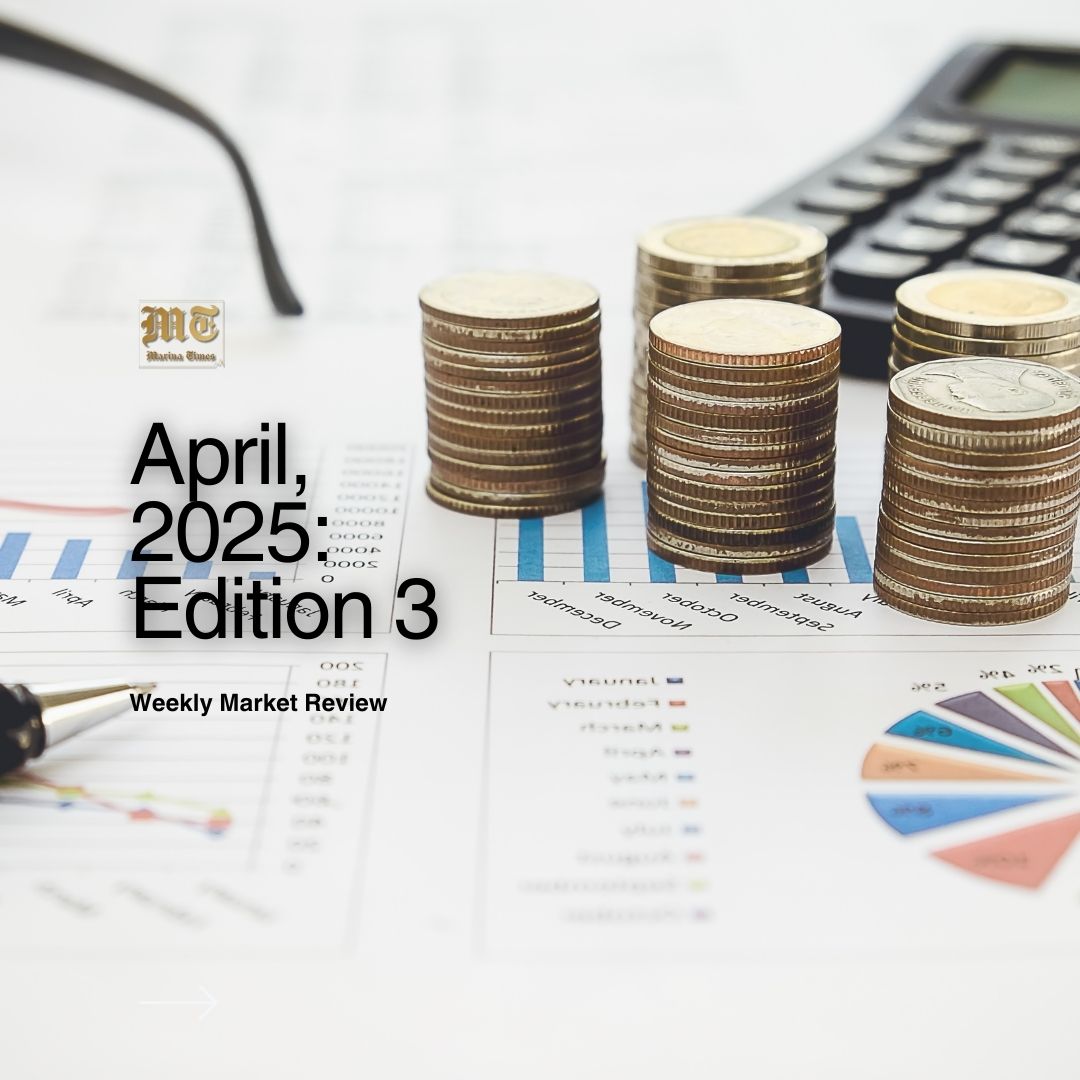

Fitch Ratings announced the upgrade of Nigeria’s Long-Term Foreign-Currency Issuer Default Rating (IDR) from ‘B-’ to ‘B.’, citing improvements in macroeconomic policy, enhanced fiscal coordination and gradual progress in structural reforms. This marks Nigeria’s credit upgrade by a major rating agency in recent times and it comes amid efforts by the current administration to stabilise the economy and attract foreign investment.
Nigeria’s headline inflation rose to 24.23% in March 2025, up from 23.18% in February, according to data released by the National Bureau of Statistics (NBS). This marks the continuing worrying trend of rising prices and eroding household purchasing power. The latest figure extends the inflationary streak that has plagued the economy since the removal of petrol subsidies and the liberalisation of the Naira in 2023. It also reinforces concerns about the effectiveness of monetary policy tools in an environment dominated by structural supply-side constraints.
As the Debt Management Office (DMO) prepares for the April 2025 Federal Government of Nigeria (FGN) bond auction, attention is firmly on the state of the economy, the pricing of government debt and investor appetite in a high-inflation, high-interest-rate environment.
In the week under review, system liquidity was appreciable throughout the week, save for Thursday, where we saw a liquidity deficit. The Naira fluctuated between a high of $/₦1,630.00 on Monday and a low of $/₦1,590.00 on Tuesday, closing at $/₦1,600.50 on Thursday. The money market saw a liquidity deficit of over ₦100 billion on Thursday. In line with this, short-term borrowing rates saw an increase, with the O/N rate rising to 32.055% from the previous week’s 26.86%, while the OPR also rose to 31.60% from the previous week’s 26.50%
The upgrade by Fitch Ratings follows a series of policy shifts, particularly in monetary and foreign exchange management. The Central Bank of Nigeria (CBN) has moved toward unifying the exchange rate regime, increased transparency in FX operations and cleared part of the historical FX backlog which is a long-standing concern among investors.
The government’s removal of fuel subsidies, reforms in energy pricing and improvements in tax administration have also contributed to enhanced fiscal performance. Fitch acknowledged these as steps that, while politically sensitive, are crucial to restoring long-term fiscal sustainability.
Although ‘B-’ and ‘B’ are relatively in the same category referred to as ‘highly speculative,’ it is still a step in the right direction as it is only a step below the ‘B+’ level. Fitch also highlighted Nigeria’s improving external metrics, with the gross reserves stabilising around $34.5 billion (as of March 2025), aided by oil receipts and external support.
This upgrade, while modest in credit terms, signals a turning tide in investor sentiment. It improves Nigeria’s perception in international capital markets and may lower borrowing costs for sovereign and corporate issuers, encourage portfolio inflows into government securities and listed equities and strengthen the Naira in the medium term by supporting FX inflows.
While the upgrade is a positive signal, it also sets a benchmark for continued reform. For Nigeria to climb further up the ratings ladder, it must sustain FX reforms and liquidity, deepen non-oil revenue mobilisation and address structural bottlenecks in power, logistics and security.
A closer look at the March inflation report reveals key contributors. Food inflation, the most volatile and politically sensitive component, soared to 31.8% year-on-year. Major drivers include security-related disruptions in agricultural belts, higher transport costs linked to fuel price liberalisation and post-harvest losses due to inadequate storage infrastructure.
Core inflation (which excludes food and energy) climbed to 20.4%, reflecting sustained cost pressures in housing, healthcare, and education — areas less influenced by seasonal supply changes. On the other hand, imported inflation remains an issue, as a weaker Naira continues to raise the cost of foreign goods and inputs, particularly in manufacturing and pharmaceuticals.
In previous times, the Central Bank of Nigeria (CBN) has responded by tightening policy aggressively with the aim to anchor inflation expectations and defend the Naira. However, the effectiveness of these measures remains limited, as the bulk of inflationary pressure stems from supply-side constraints rather than excessive demand.
Moreover, rising interest rates have increased borrowing costs for businesses and governments alike, raising concerns about access to credit and future investment growth.
The consequences of rising inflation are visible across every stratum of society. Households face shrinking real incomes, with staples like rice, yam and vegetable oil now unaffordable for many low-income earners. SMEs and manufacturers are dealing with soaring input costs and thinning margins, often passing these on to consumers.
In the face of growing economic strain, labour unions are intensifying pressure on the government to raise the national minimum wage, a move that, while aimed at cushioning households, could carry long-term fiscal risks by further fuelling inflation.
Analysts expect inflation to remain elevated through Q2 2025, especially as planting season constraints and FX pressures linger. Further fiscal coordination may be required to shield the most vulnerable while reforms are implemented.
In March 2025, the Federation Account Allocation Committee (FAAC) disbursed a total of ₦1.578 trillion to the federal, state and local governments, marking the third consecutive monthly decline and raising questions about fiscal sustainability at all levels of government.
While the headline figure may still appear substantial, the trend paints a worrying picture of declining public revenues, particularly in the face of mounting inflation and rising governance costs.
The reduction in FAAC allocations stems from a confluence of factors. Despite elevated global oil prices, Nigeria’s crude oil production has remained below capacity, averaging 1.45 million barrels per day (mbpd) in Q1 2025, well short of the 1.8 mbpd OPEC quota.
Persistent issues such as pipeline vandalism, crude theft and ageing infrastructure continue to drag output. This underperformance has significant fiscal implications. The 2025 budget is benchmarked at 2.06 mbpd and $75 per barrel. Unless production rebounds or non-oil revenues overperform, the Debt Management Office (DMO) may be forced to ramp up borrowing to plug the widening deficit.
Moreover, under-recovery costs and exchange rate adjustments have further constrained the net oil revenue available for distribution. The liberalisation of the Naira has led to significant fluctuations in oil export receipts when converted to local currency. While the official rate has become more market-reflective, unpredictability has made it harder for the government to forecast inflows accurately.
Non-oil revenue collection, while improving due to reforms at the Federal Inland Revenue Service (FIRS), remains insufficient to offset the volatility in oil-linked inflows. Compliance issues, narrow tax nets and informal sector dominance continue to limit revenue mobilisation.
For many subnational governments, FAAC remains the primary source of funding, with limited internally generated revenue (IGR) to fall back on. The sustained drop raises several concerns such as delayed salary payments and mounting arrears in some states, slowdown in capital project execution, especially in infrastructure and social services and increased domestic borrowing, further ballooning the debt profile of state governments.
As capital expenditure plans are adjusted downwards, economic activity at the grassroots level could take a hit, undermining broader growth and development goals.
In expectation of the first bond auction for Q2, with inflation at 24.23% and the Monetary Policy Rate (MPR) to 27.50%, yields on government securities have come under renewed scrutiny. Market participants are watching closely to assess whether the federal government can continue to attract sustainable funding at competitive rates without worsening debt-service costs.
Nigeria’s 2025 budget includes a deficit of about ₦9 trillion, a significant portion of which is expected to be financed through domestic borrowing. The FGN bond auction is one of the primary tools used by the DMO to raise long-term funds for government expenditure, including infrastructure, social services, and debt refinancing.
In previous months, the DMO successfully raised funds through multi-tenor bond issuances. These auctions have seen strong participation from local pension funds, banks and insurance companies, with foreign investor interest picking up slightly following the Fitch credit upgrade.
Investor confidence has been cautiously improving on the back of the recent upgrade by fitch ratings, moving nigeria from ‘B-‘ to ‘B’, FX reforms and increased clarity around monetary policy direction. However, the outlook remains mixed due to the new inflation figure, uncertainty around FX stability, particularly regarding liquidity in the official market and concerns over Nigeria’s debt sustainability.
The April bond auction, given the high inflation environment, the DMO may need to offer more attractive real yields to maintain demand momentum. The outcome of the April auction will serve as a yardstick for several macroeconomic themes.
If the auction clears successfully at reasonable rates, it could boost confidence in Nigeria’s fixed income market and provide further support to the Naira. A weak auction, however, may prompt concern over fiscal stress or the need for even higher yields in the future.
The April bond auction will be more than just a ‘fundraising exercise,’ it will test the investor belief in Nigeria’s reform trajectory and economic outlook. As the government balances its need for capital with inflation and debt management challenges, the bond market will continue to serve as both a lifeline and a litmus test for economic credibility.
As events in the second quarter unfold, the economic outlook remains marked by uncertainty and ripe with potential. The recent credit upgrade by Fitch Ratings shows growing international recognition of reform efforts, particularly in FX management and fiscal coordination. However, the road ahead will test the durability of these reforms and their capacity to deliver broad-based economic stability.
Going forward, if the government can navigate reforms without derailing fiscal stability, Nigeria’s credit story could strengthen further, lowering borrowing costs and encouraging longer-term capital flows.
For fixed income investors, vigilance remains key. The macroeconomic story is still unfolding, but the trajectory suggests a cautiously optimistic outlook, contingent on reform momentum and a steady hand in monetary management.
Oil remains a critical variable in Nigeria’s macroeconomic equation. However, tariff tensions between the U.S. and China have introduced volatility, with fears that slower global trade could dampen demand. Brent and WTI benchmarks have settled in the low‑to‑mid $60s per barrel amid renewed OPEC+ discipline and escalating U.S.–China tariff tensions, which have injected fresh volatility into oil markets. The International Energy Agency (IEA) has trimmed its 2025 world oil demand growth forecast, citing trade‑war–driven slowdowns in the United States and China. For Nigeria, where oil revenues underpin foreign‑exchange liquidity and fiscal balances, a sustained production rebound coupled with firmer price momentum will be crucial to buttress ongoing macroeconomic reforms and to provide room for subsidy rationalisation and currency liberalisation.